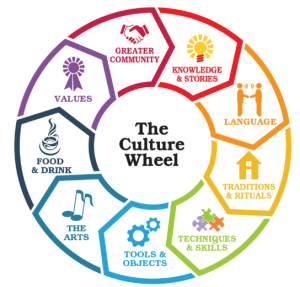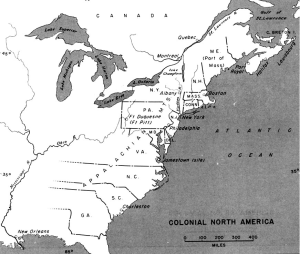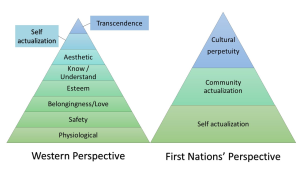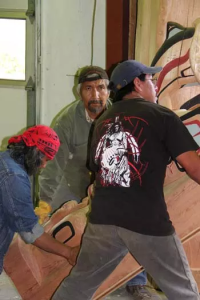11 Environmental Inequality and Culture
The environmental crisis is a social problem because people contribute to the problem and experience it differently based on their race, class, gender, and ability among other social locations. A portion of this inequality is historically rooted in the destruction of culture caused by colonialism. To understand this, we must define both culture and colonialism.
In every interaction, we all adhere to various rules, expectations, and standards that are created and maintained in our specific culture. These social norms have meanings and expectations. The meanings can be misinterpreted or misunderstood in many ways. When we do not meet those expectations, we may receive some form of disapproval. The disapproval could be as simple as a fierce look or a rude comment.
For example, someone trying to connect with you may ask: “What do you think of the weather we’re having?” A common response in Oregon might be, “I’m so tired of the rain.” If you ignored the question, you would be violating a norm. Alternatively, if you responded with your detailed analysis of climate change, you would also violate the norm of a “greeting.” Instead of a short, calm statement, you respond in a detailed and emotional way, not meeting the other person’s expectations. These norms and the norm violations are concrete examples of culture.
Culture is the shared beliefs, values, and practices that are transmitted within a social group. Culture includes:
- shared values,
- beliefs that strengthen the values,
- norms, and rules that maintain the values,
- language so that the values can be taught,
- symbols that form the language people must learn,
- arts and artifacts,
- and the people’s collective identities and memories.
We examine social situations to discover the expectations for norms and behaviors. People who interact within a shared culture create and enforce these expectations. Sociologists examine these circumstances and search for patterns.
Enculturation and Cultural Universals
Anthropologist Edward Tyler (1871) was one of the earliest social scientists to define culture, stating that it was “that complex whole which includes knowledge, belief, art, morals, law, custom, and any other capabilities and habits” that people learn from other members of their group. In other words, culture is taught and learned. Anthropologists call the process of learning culture enculturation.
A Western example of enculturation is the belief that we must work to earn the right to live. Children are taught from a young age that we must work jobs until we become elderly to afford our basic necessities, such as food, shelter, water, and acceptance within our communities. This is steadily reinforced throughout adolescence and into adulthood through toys, media, job fairs, career days, and paychecks.
Culture also includes the institutions we create, the mental maps we perceive to be “reality,” and the power structures that shape our understanding of the world. It is important to note that culture is not static. Rather, it is a constantly evolving dynamic process, being shaped, reinforced, and negotiated by members within the cultural group. We learn culture from our parents and other family members, our teachers and religious leaders, the media, and the larger communities and societies we are a part of. Fundamental to the definition of culture is that it is a shared experience that develops in response to being a group member.
All cultures have to solve similar problems: how to find enough to eat, how to raise children, how to care for the sick, and how to memorialize those who have died. Although cultures vary, they also share common elements. Cultural universals are patterns or traits that are globally common to all societies.
One example of a cultural universal is the family unit. Every human society recognizes a family structure that regulates sexual reproduction and the care of children. Even so, how that family unit is defined and how it functions vary. In many Asian cultures, for example, family members from all generations commonly live together in one household. In these cultures, young adults continue to live in the extended household family structure until they marry and join their spouse’s household, or they may remain and raise their nuclear family within the extended family’s homestead.
In the White dominant culture of the United States, by contrast, individuals are expected to leave home and live independently for a period before forming a family unit that consists of parents and their offspring. Other cultural universals include customs like funeral rites, weddings, and celebrations of births. However, each culture may view and conduct the ceremonies quite differently. Even humor may be a cultural universal—a way to release tension and create unity (Murdock 1949). You may not always get the joke of a person from another culture, but it seems that everyone laughs.
The Culture Wheel
As a sociologist exploring a social problem, you might look at how the cultures of the participants reflect different values, norms, languages, or laws in order to better understand the conflict. To remind ourselves of what these cultural differences can be, we have the culture wheel to help (figure 8.9).

Figure 8.9. The culture wheel visually represents a specific culture’s beliefs, actions, and backgrounds. The culture wheel helps us to understand what is common and different in many cultures. When you consider your own cultural background, how is it the same or different from the dominant culture? Figure 8.9 Image Description
How might you use this culture wheel to explain your own culture to someone else?
Part of why the conflict is so hard to resolve regarding the environment is that we see a deep conflict between culture and the related world views.
According to Alan Johnson, a sociologist you met in Chapter 1 , a worldview is:
The collection of interconnected beliefs, values, attitudes, images, stories, and memories out of which a sense of reality is constructed and maintained in a social system and in the minds of individuals who participate in it. (Johnson 2014:180)
Like culture, a worldview helps a person make sense of their world. A worldview is a perception of reality reinforced by people in a society. For example, in the dominant worldview in the United States, people think that the concept of race is based on biology. In this worldview, you can tell someone’s race by looking at physical characteristics such as skin tone, eye shape, or hair texture.
In a worldview that incorporates social construction, we see race is a social construct, not a biological one. Even being White is a social construction resulting from a combination of capitalism and colonialism. Initially, the English used “race” to divide English people from Irish people, legitimizing taking Irish land. Once created, “race” as applied to Indigenous, African, and other “non-white” people became a justification for genocide, slavery, domination, and colonization (Johnson 2014).
Unpacking Oppression, Living Justice: Colonialism
Many schoolchildren in the United States can tell us that our country began as thirteen colonies. However, this basic understanding is a bit flawed.

Figure 8.10. Colonial North America (1689-1783) How many colonies do you see?
This map of colonial North America (1689-1783) shows the 13 colonies school children learn about. It also shows the 4 colonies that became part of Canada. To the far north, Halifax is a major city in Nova Scotia, the city of Quebec is part of the colony of Quebec, Prince Edward Island is the tiny island just northwest of Halifax, and only a tiny corner of Newfoundland shows up on the far upper right corner. Even countries are socially constructed.
Immediately before the American Revolution, Great Britain actually had 17 colonies. Thirteen of these colonies eventually revolted. They became the new country, the United States of America. The other colonies, Newfoundland, Nova Scotia, Quebec and Prince Edward Island, remained colonies of Great Britain. These original colonies became part of the Confederation of Canada in 1867. Canada became fully independent of Great Britain in 1982.
The school child version of the thirteen colonies also simplifies a much more complicated reality. The more nuanced version of this history includes violence and genocide under the practice of colonialism.
Colonialism is the domination of a people or area by a foreign state or nation. When we say that Great Britain colonized North America, we mean that Great Britain made the laws, provided the leaders, bought animal furs, wood, and minerals, and imposed taxes. The colonizers who lived here were citizens of Great Britain, but had no rights to vote. Indigenous people and slaves had even less.
Figure 8.11. The History of the World: Every Year [YouTube]. Please watch minutes 16 – 18:09, spanning from 1550 to 1970. In this period, we see political colonialism increase and decrease. Also, the video itself takes the perspective of colonizers. For example, Australia is empty, but we know that the Indigenous Aboriginal people have lived there since before time.
It can be challenging to imagine the sheer scope of colonial domination. Please watch the video in figure 8.11, particularly minutes 16 – 18:09. In this video, we see that Spain, Portugal, France, England, China, and Russia were major colonizing powers. Starting about video minute 16, in the 1550s, we can see the expansion of Spain and Portugal into Central and South America. By video minute 16:30, or the 1620s, France, England, and the Netherlands established colonies in North America. By about video minute 17:17, about the year 1800, we see Great Britain establishing colonies in Australia and Canada. Much of Africa was “owned” by Spain, Portugal, and Great Britain. It was only after World War II and the rise of nationalism in the 1950s and 1960s that the power of colonialism waned. The map at video minute 18:09 shows mostly independent states worldwide.
Today, some places in the world are still colonies or territories of other states. Puerto Rico is a U.S. territory. The people who live there are U.S. citizens, but they can’t vote in many elections. Similarly, the Falkland Islands, small islands off the coast of Argentina, are legally recognized as territories of the United Kingdom and claimed as part of Argentina simultaneously. However, most of the world’s countries govern themselves independently. Why, then, is colonialism still important?
Learning about colonialism is necessary because we still feel the effects of this historical legacy. European world powers established global slavery in this time period. Colonizers killed the people who already lived on the land through disease, war, and resettlement. Colonizers used education as a way of destroying family and community. Colonial practices fuel climate change. Part of the reason for that begins with differences in worldview.
It’s your turn to unpack colonialism and live justice:
Compare the colonization video and the native lands map project.
Consider these questions:
- Who is creating the map? (You might want to look at the About section on the native lands page.)
- What is included and excluded?
- What worldview does each map support?
- How might this impact climate change?
Worldview Conflict – Indigenous and Western Perspectives
Although Indigenous peoples worldwide are significantly different from one another, Indigenous people, social scientists, and activists assert that there is an Indigenous worldview. From Chapter 1, we remember that the social construction of language is important. Let’s talk first about the terms that we use to describe the first people who live in any place: Indigenous, First Nation, and Indian.
The United Nations describes Indigenous peoples in this way:
Indigenous peoples have in common a historical continuity with a given region prior to colonization and a strong link to their lands. They maintain, at least in part, distinct social, economic, and political systems. They have distinct languages, cultures, beliefs, and knowledge systems. They are determined to maintain and develop their identity and distinct institutions, and they form a non-dominant sector of society. (United Nations n.d.)
The United Nations doesn’t define who is indigenous on purpose, asserting that indigenous people have the right to identify themselves for themselves.
In an alternate definition, the Canadian organization Indigenous Foundations defines First Nations as:
a term used to describe Aboriginal peoples of Canada who are ethnically neither Métis nor Inuit. …. You may also hear some First Nations people refer to themselves as “Indians.” While there are many reasons for an individual to self-identify this way, this may be a deliberate act on their part to position and present themselves as someone who is defined by federal legislation. (First Nations Studies Program n.d.)
Although Indigenous people throughout the world have very different cultures, their collective worldview is significantly different from the Western worldview. If you’d like, please read this story, “What I Learned from Coyote,” and this explanation of worldview, “As I had shared with Coyote.” In them, Jennifer Anaquod, indigenous educator, researcher, and member of the Muscowpetung Saulteaux First Nation in Saskatchewan, describes her worldview through story. Describing the world through story is part of Indigenous culture.
We’ve summarized some core differences between Indigenous and Western worldviews in the table in figure 8.12. Each worldview defines relationships to wealth and to land, among other components. In the Indigenous view, land is sacred. Generation after generation, people care for the land and are nourished in return. Wealth is shared. In the Western worldview, land is owned or controlled. The purpose of living is to accumulate individual wealth. This belief supports the economic practices of capitalism. And, as a reminder, it is important to understand that not all indigenous people have an indigenous worldview. Not all Western people have a Western worldview.
| Indigenous Worldview | Western Worldview |
| Collectiveness | Individualism |
| Shared wealth | Accumulate wealth |
| Natural world more important | People’s laws are more important |
| Land is sacred. We belong to the land, | Land is a resource, is dangerous, and must be controlled. |
| Silence is valued. | Silence needs to be filled. |
| Generosity | Scarcity |
| Binaries do not exist. | Binaries are crucial. |
Figure 8.12. Differences between the Indigenous World View and the Western World View. Even creating a chart that divides things into two categories is an example of the Western Worldview.
We also see a difference in worldview when we examine how we understand what people need to thrive and grow. You may have seen the triangle on the left of figure 8.13 at some point in your education. In figure 8.13, the triangle (left) shows Maslow’s hierarchy of needs.

Figure 8.13. C omparison between Maslow’s Hierarchy and First Nations Perspective.
Maslow’s Hierarchy focuses on the individual. The First Nations Perspective includes the health of the collective now and in the future. It includes the emotional need for affection and loving connections to others once basic physiological and biological needs are met. In contrast, the triangle on the right in figure 8.13 shows theories created by multiple indigenous groups, including the Blackfoot Nation in North America. This model emphasizes the self-actualization of not just the individual but of the community as the most primary of needs.
In 1938, American psychologist Abraham Maslow spent time with the people of the Blackfoot Nation in Canada prior to releasing his Hierarchy of Needs theory (figure 8.13). Historians think he based the teepee-like structure on the Blackfoot ideas but westernized the focus on the individual rather than the community (Bray 2019).
Let’s look more closely at the representation of Blackfoot ideas. It can be seen that the well-being of the individual, the family, and the community are based on connectedness: the closeness that we experience with family and friends, and the prosocial extension that we provide to others in our communities and in the world. In addition, this model focuses on time; the top of the teepee is cultural perpetuity, and it symbolizes a community’s culture lasting forever.
As powerful as cultures and worldviews are, they need action in the world to become real. One institution that encapsulates our values is the economy. Let’s look next at how colonialism and capitalism work together to exacerbate the social problem of climate change.
Colonialism, Capitalism, and Climate Change
An example that illustrates the differences between the dominant Western perspective today versus the Indigenous or First Nations perspective is the economic system of capitalism. Capitalism is an economic system based on private ownership and the production of profit. This economic system requires endless consumption and use of resources, which is not sustainable on a finite planet.
When the goal is profit, people must buy more and more things. Creating more and more things uses even more planetary resources. This drive for profit shapes our values and our behaviors. For example, capitalism often requires conspicuous consumption, the purchase of expensive luxury goods or services to display one’s wealth and status. It is not enough to have a small house with running water, heat, and electricity.
Instead, capitalism requires that people always want more: a mansion, two cars, a swimming pool, and a fancy vacation. We can see conspicuous consumption at work when we examine what people eat around the world. If you want to learn more, The Great Global Food Gap [website] shows images of what families across the globe buy for food. (Please note: as of 2023, a British pound (£) is worth slightly less than a United States dollar ($)). How much must you spend on food to meet your basic needs? How does that amount change when considering a diet that will make you happy?

Figure 8.14. Carvers Owen James, Herb Sheakley, and tribal member George Dalton, Jr. hoist the Kaagwaantaan house post.
Traditional Ecological Knowledge (TEK) is a rich source of wisdom. Indigenous or First Nation’s economic systems generally have not relied on exponential growth and consumption to live a healthy lifestyle. Many journals from early colonists describe the Americas as places with lush and ample resources. Indigenous peoples had consistently managed and stewarded the land using techniques perfected throughout generations. This knowledge today is called Traditional Ecological Knowledge, or TEK. To learn more about TEK, read Native Knowledge: What Ecologists Are Learning from Indigenous People [website].
In addition to the decimation of Indigenous populations and the land that they lived on, colonization supported a worldview that contributed to ecological devastation today. In this view, land should be owned and subjugated, rather than tended and cared for. In the words of authors Laura Dominguez and Colin Luoma (who write using UK English):
The widespread plunder of natural resources was a hallmark of colonisation. Nature was something that was to be commodified in order to enrich the colonial power. In turn, indigenous territories were treated as business enterprises, with seemingly unlimited resources to exploit. Undoubtedly, this had dire environmental consequences. Only upon the realisation that their activities were causing rapid environmental degradation did colonisers begin to concern themselves with nature conservation. This brought about early attempts by colonisers to preserve indigenous lands—notwithstanding the fact that indigenous peoples have been conserving their own traditional territories for centuries prior to European contact. Yet the ideology that emerged was that nature was something that should be first exploited, then preserved, but all without the input, involvement, or participation of indigenous populations. (Dominguez and Luoma 2020)
Further, colonization supports a worldview that leads its participants to value individual well-being above all else. This leads to a lack of action and concern regarding the well being of our neighbors, plants, and animals who surround us.
Examples from Australia, New Zealand, and Latin America show the link between colonization, capitalism, and climate change.
In many areas of the world, European colonizers needed wood. Wood was essential in building houses and ships. It was a major source of fuel for heating and cooking. In New Zealand, one of the main reasons that colonists took over Maori land was to extract timber. This resulted in 60% less forest and the extinction of many native animal species (Varanasi 2022). Similarly, in Australia, colonizers banned Indigenous wildfire management practices. They thought that banning fire would protect the forests. However, the Indigenous practices enhanced biodiversity and protected the forests.
We see the result of these colonial practices even today. In 2019 and 2020, Australia was devastated by catastrophic wildfires, and 34 people died in these wildfires. These fires destroyed 72,000 square miles of land and 3,500 homes. The fires also killed or displaced about 3 billion animals. In addition, they released significant carbon dioxide, which continuously fuels climate change (Center for Disaster Philanthropy 2020; Pratt 2021).
We also see links between colonization, capitalism, and climate change in South and Central America. Uruguayan journalist and poet Edwardo Galeano wrote The Open Veins of Latin America in 1971. In it, he argued that capitalism based on colonization created poverty in Latin America. He writes:
Latin America is the region of open veins. Everything from the discovery until our times, has always been transmuted into European–or later–United States– capital, and as such has accumulated on distant centers of power. Everything: the soil, its fruits and its mineral-rich depths, the people and their capacity to work and to consume, natural resources and human resources. (Galeano 1971:2)
He also wrote a poem “Las Nadies/The Nobodies,” which describes the impact of colonial capitalism on the people who live in the colonized countries. In it, the people are nobodies. He wrote, “We don’t have culture, but folklore,” among other losses. In this poem, we see the importance of culture. We see another emphasis on “those who contribute the least suffer the most.” Again, we notice the power of capitalist colonialism. If you’d like to listen to this poem, watch Los Nadies/The Nobodies Poem [Video].
The legacy of colonialism and capitalism on climate change continues in Latin America today. The world markets for beef, soybeans, palm oil, wood products, sugar, and coffee support continued deforestation (Union of Concerned Scientists 2016). Deforestation itself is a cause of climate change.
Environmental inequality arises from cultural differences in worldviews and the economic systems that drive those worldviews. This conflict provides the context for making sense of the climate crisis today.
Licenses and Attributions for Environmental Inequality and Culture
Open Content, Original“Environmental Inequality and Culture” by Kimberly Puttman and Avery Temple, is licensed under CC BY 4.0. Unpacking Oppressing, Living Justice: Colonialism by Kimberly Puttman is licensed under CC BY 4.0. 5.3 Values and 5.3.1 Enculturation is adapted from “Chapter 3 Introduction” and “3.1 What is Culture” by Tonja R. Conerly, Kathleen Holmes, Asha Lal Tamang, Openstax Sociology 3e is licensed under CC BY 4.0. Modifications: Summarized some content and applied it specifically to the social problem of climate change. License Terms: Access for free at https://openstax.org/books/introduction-sociology-3e/pages/1-introduction Open Content, Shared PreviouslyFigure 8.10 File:Colonial North America 1689 to 1783.jpg by United States Army Center of Military History is in the Public Domain Figure 8.12 Differences between the Indigenous World View and the Western World View by Avery Temple. License: CC BY 4.0. Figure 8.13 Maslow’s Hierarchy and First Nations Hierarchy Contemporary Families: An Equity Lens by Elizabeth B. Pearce; Wesley Sharp; and Nyssa Cronin is licensed under a CC BY 4.0, except where otherwise noted. Figure 8.14 Carvers Owen James and Herb Sheakley, and tribal member George Dalton, Jr. hoist the Kaagwaantaan house post from National Park Service is in the Public Domain. All Rights Reserved ContentFigure 8.9 “The Culture Wheel” (c) AndreaGrace J. Fonte Weaver. All Rights Reserved. Used with permission Figure 8.11 “The History of the World Every Year” © Ollie Bye. License Terms: Standard YouTube License. |

